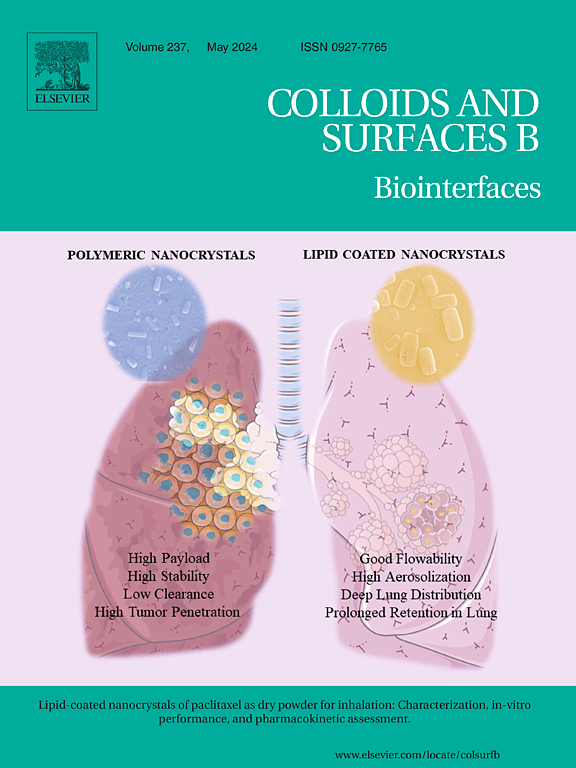巴西橡胶颗粒的流体界面显示了颗粒大小对早期凝结步骤的影响。
IF 5.4
2区 医学
Q1 BIOPHYSICS
引用次数: 0
摘要
天然橡胶源自巴西橡胶树胶乳的橡胶颗粒(RP)的凝结。Hevea RP 的尺寸分布呈双峰型,存在小橡胶颗粒(SRP)和大橡胶颗粒(LRP)。本研究旨在根据粒度更好地了解 Hevea RP 的早期凝结步骤。SRP 和 LRP 是通过离心分离 RRIM600 克隆的新鲜无氨胶乳获得的。粒度和 zeta 电位测量结果表明,两种胶乳馏分都能在碱性缓冲液中有效分离并保持稳定。将 SRP 和 LRP 分散液置于 Langmuir 槽中,让 RP 在空气-液体界面上吸附,形成界面薄膜。表面张力和椭偏仪表明,SRP 的形成动力学和薄膜在气液界面的稳定性比 LRP 快。此外,布儒斯特角显微镜、原子力显微镜和共聚焦激光扫描显微镜显示,SRP 和 LRP 在界面上的 RP 排列方式也有所不同。首先,RP 膜和顺式-1,4-聚异戊二烯核心在气液界面上扩散,然后聚成一团。然后,在 SRP 融合的同时,LRP 在浮动聚合体中保持其单个颗粒的结构。讨论了非异戊二烯分子对 SRP 和 LRP 薄膜不同组织结构的作用,以及两种主要 RP 蛋白 SRPP1(小橡胶颗粒蛋白)和橡胶伸长因子 (REF1) 在早期凝结步骤中的作用。本文章由计算机程序翻译,如有差异,请以英文原文为准。
Hevea brasiliensis rubber particles' fluid interfaces reveal size impact on early coagulation steps
Natural rubber originates from the coagulation of rubber particles (RP) from Hevea brasiliensis latex. The size distribution of Hevea RP is bimodal with the presence of small rubber particles (SRP) and large rubber particles (LRP). This study aims at getting a better understanding of the early coagulation steps of Hevea RP taking into account the particle size. SRP and LRP were obtained by centrifugation of freshly tapped ammonia-free latex from RRIM600 clone. Size and zeta potential measurements showed that both RP fractions were efficiently separated and stable in basic buffer. SRP and LRP dispersions were placed in a Langmuir trough and RP were let to adsorb at the air-liquid interface to form interfacial films. Surface tension and ellipsometry indicate that the formation kinetics and the stabilization of the film at the air-liquid interface are faster for SRP than LRP. Moreover, the arrangement of RP at the interface differs between SRP and LRP, as shown by Brewster angle microscopy, atomic force microscopy and confocal laser scanning microscopy. First, the RP membrane and cis-1,4-polyisoprene core spread at the air-liquid interface before clustering. Then, while the SRP fuse, the LRP keep their structure in individual particles in floating aggregate. The role of the non-isoprene molecules on the different organization of SRP and LRP films is discussed, the one of the two major RP proteins, SRPP1 (Small Rubber Particle Protein) and Rubber Elongation Factor (REF1) in the early coagulation steps.
求助全文
通过发布文献求助,成功后即可免费获取论文全文。
去求助
来源期刊

Colloids and Surfaces B: Biointerfaces
生物-材料科学:生物材料
CiteScore
11.10
自引率
3.40%
发文量
730
审稿时长
42 days
期刊介绍:
Colloids and Surfaces B: Biointerfaces is an international journal devoted to fundamental and applied research on colloid and interfacial phenomena in relation to systems of biological origin, having particular relevance to the medical, pharmaceutical, biotechnological, food and cosmetic fields.
Submissions that: (1) deal solely with biological phenomena and do not describe the physico-chemical or colloid-chemical background and/or mechanism of the phenomena, and (2) deal solely with colloid/interfacial phenomena and do not have appropriate biological content or relevance, are outside the scope of the journal and will not be considered for publication.
The journal publishes regular research papers, reviews, short communications and invited perspective articles, called BioInterface Perspectives. The BioInterface Perspective provide researchers the opportunity to review their own work, as well as provide insight into the work of others that inspired and influenced the author. Regular articles should have a maximum total length of 6,000 words. In addition, a (combined) maximum of 8 normal-sized figures and/or tables is allowed (so for instance 3 tables and 5 figures). For multiple-panel figures each set of two panels equates to one figure. Short communications should not exceed half of the above. It is required to give on the article cover page a short statistical summary of the article listing the total number of words and tables/figures.
 求助内容:
求助内容: 应助结果提醒方式:
应助结果提醒方式:


